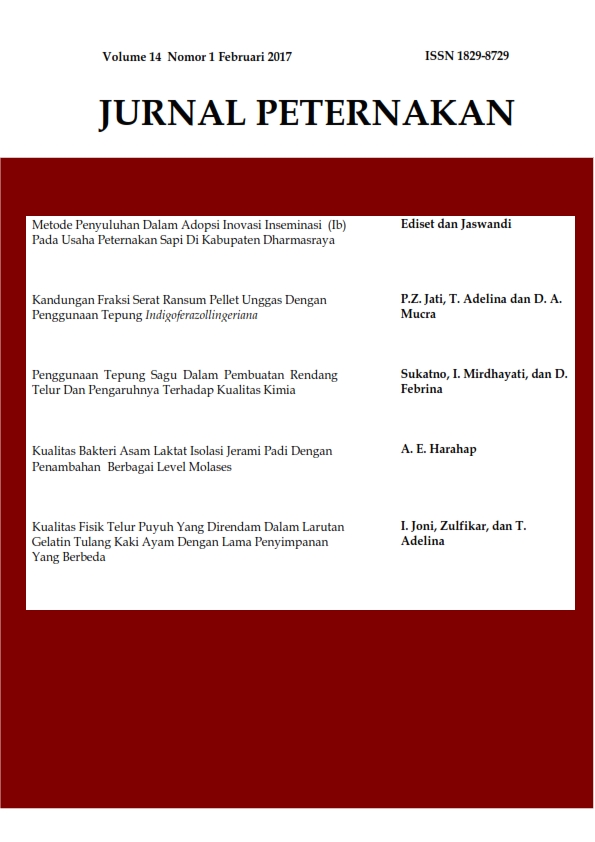Kualitas Bakteri Asam Laktat Isolasi Jerami Padi Dengan Penambahan Berbagai Level Molases
DOI:
https://doi.org/10.24014/jupet.v14i1.3398Keywords:
Lactic Acid Bakteria, silage, rice straw, molasse, , antimicrobialAbstract
One of the problems in the development of ruminants, especially in the dry season is difficult to feed of quantity and quality. The aim of this research is to study of pH, the number of colonies of Lactic Acid Bacteria, antimicrobial isolated from rice straw silage with the addition of levels of molasses. This research was conducted from Juli until November 2015 at Laboratory of Agrosotology, Feed Industry and Soil Science, Faculty of Agriculture and Animal Science, State Islamic University of Sultan Syarif Kasim Riau.. The research method of rice straw silage with the addition of various levels of molasses, isolation of lactic acid bacteria and antimicrobial effect. The method used to analyze pH, the number of colonies of Lactic Acid Bacteria, and antimicrobial effect is exploration by using descriptive analysis. The conclusion that treatment of rice straw silage by adding molasses 9% level pH content, the number of colonies and the antimicrobial effect better than the other treatments.References
Alakomi HL, Skyttä E, Saarela M, Mattila ST, Latva KT, Helander IM. 2000. Lactic acid permeabilizes gram-negative bacteria by disrupting the outer membrane. Appl Envir Microb 66 : 2001–2005.
Axelsson L. 1998. Lactic acid bacteria: Classification and physiology. Di dalam: Salminen S, Wright and A Von Wright, Editor. Lactic Acid Bacteria: Microbiology and functional aspects, 2nd Edition, Revised and Expanded. New York: Marcel Dekker Inc. pp
–72.
Cintas LM, Rodriguez JM, Fernandes MF, Sletten K, Nes IF, Hernandez PE, Holo H.
Isolation and characterization of
Pediocin L50, a new bacteriocin from Pediococcus acidilactici with a broad inhibitory spectrum. Appl and Envir Microbiology. 61(7): 2643–2648.
Fardiaz S. 1992. Mikrobiologi Pangan I. Jakarta: Gramedia Pustaka Utama. Jakarta.
Janson S. 2005. Lactic acid bacteria in silage – growth, antibacterial activity and antibiotic resistance [thesis]. Swedia: Department of microbiology swedish university of agricultural sciences
Kaiser, A.G. and J.W. Piltz. 2002. Silage production from tropical forages in Australia. Presented at the XIII th International Silage Conference, 11–13th September,
http://www.fao.org/ag/AGP/AGPC/doc/sila ge/ Kaiser paper/Kaiser silage. htm.
Lendrawati, 2008. Kualitas Fermentasi dan Nutrisi Silase Ransum Komplit Berbasis Hasil Samping Jagung, Sawit dan Ubi Kayu. Institut Pertanian Bogor (Tesis). Bogor
McDonald P, Henderson AR, Heron SJE. 1991.
The Biochemistry of Silage. Second Edition,
Marlow: Chalcombe.
McDonald P, Henderson AR, Heron SJE. 2002.
The Biochemistry of Silage. Second Edition,
Marlow:
Parakkasi A. 1999. Nutrisi dan Makanan Ternak Ruminan. Universitas Indonesia Press. Jakarta.
Putun, A.E., E. Apaydin dan E. Putun. 2004. Rice straw as a bio-oil source via pyrolysis and steam pyrolysis. Energy The International J.
(12–15):2171–2180. October-December
http://www.linkinghub. elsevier.com/retrieve/pii/S036054420400098
Susanto, S.S. dan Andjanidani, A. 1985.
Penggunaan Tetes (Cara Molasses) sebagai
Bahan Penyusun Ransum Anak Ayam Pedaging. Proceedings Seminar Pemanfaatan Limbah Tebu untuk Pakan Ternak. Pusat Penelitian dan Pengembangan Peternakan, Badan Penelitian dan Pengembangan Pertanian. Departemen Pertanian. Bogor
Schroeder JW. 2004. Silage Fermentation and
Preservation. Extension Dairy Speciaslist. AS-
//www.ext.nodak.edu/extpubs/ansci/dairy
/as 1254w.htm.
Downloads
Published
Issue
Section
License
The Authors submitting a manuscript do so on the understanding that if accepted for publication, copyright of the article shall be assigned to Jurnal Peternakan and published by Fakultas Pertanian dan Peternakan Universitas Islam Negeri Sultan Syarif Kasim Riau as publisher of the journal.
Authors who publish with this journal agree to the following terms:
Authors automatically transfer the copyright to the journal and grant the journal right of first publication with the work simultaneously licensed under a Creative Commons (CC BY) that allows others to share the work with an acknowledgement of the work's authorship and initial publication in this journal.
Authors are able to enter into separate permission for non-exclusive distribution of the journal's published version of the work (e.g., post it to an institutional repository or publish it in a book), with an acknowledgement of its initial publication in this journal.
Authors are permitted and encouraged to post their work online (e.g., in institutional repositories or on their website) prior to and during the submission process, as it can lead to productive exchanges, as well as earlier and greater citation of published work (See The Effect of Open Access).

